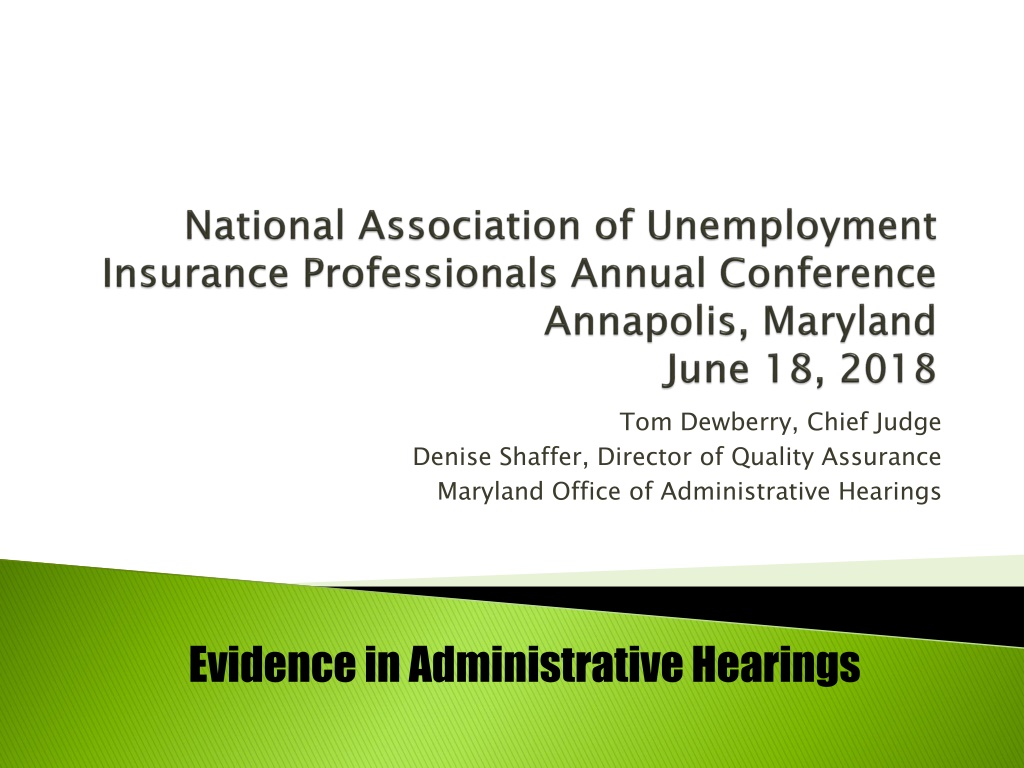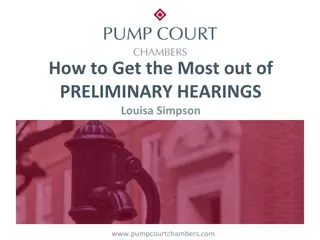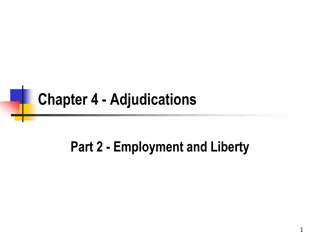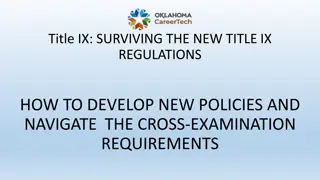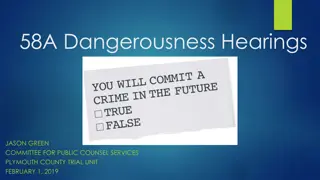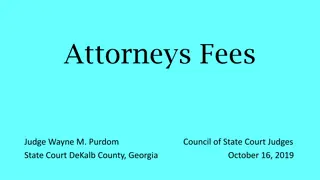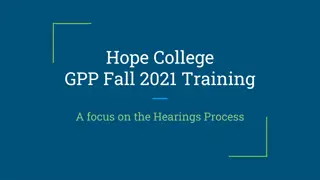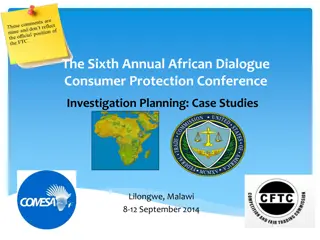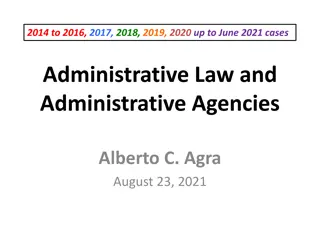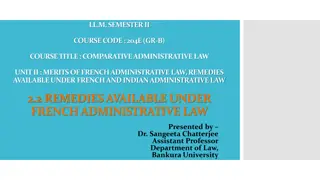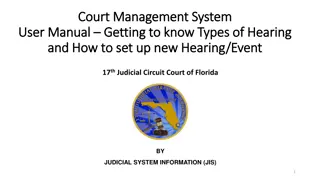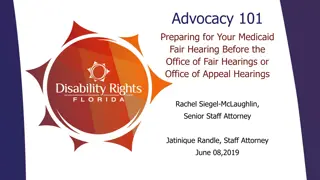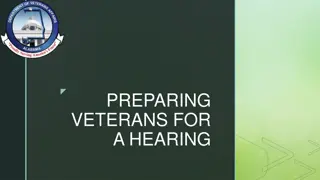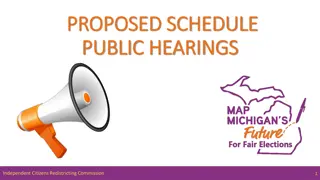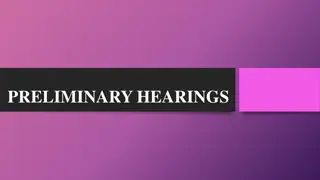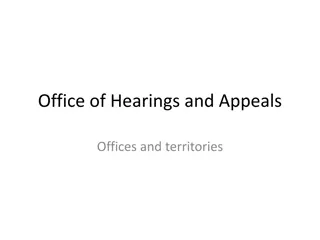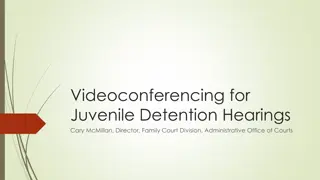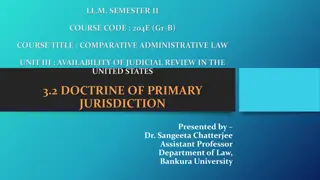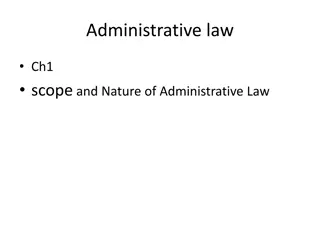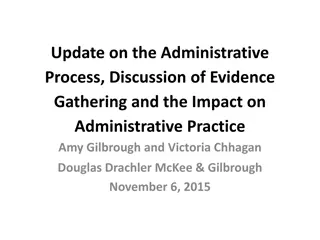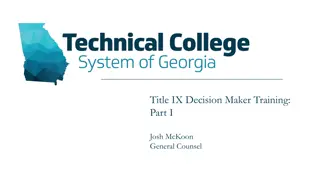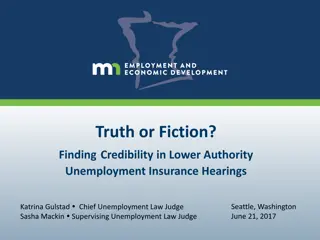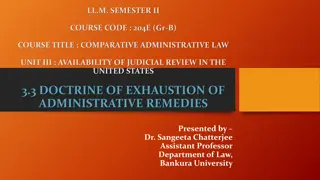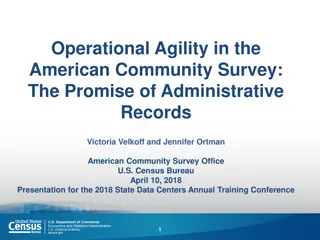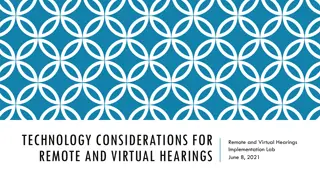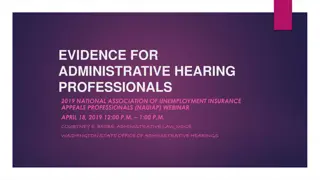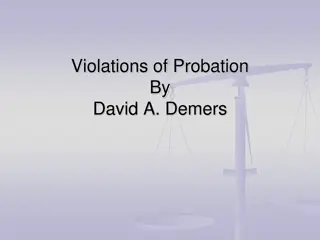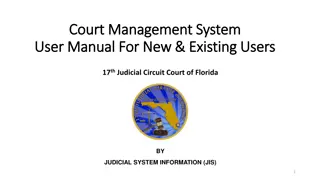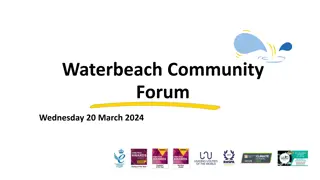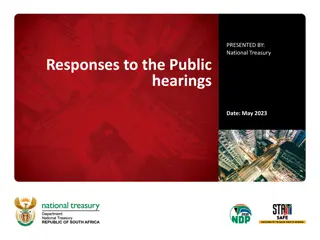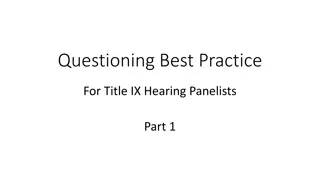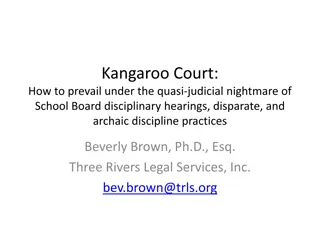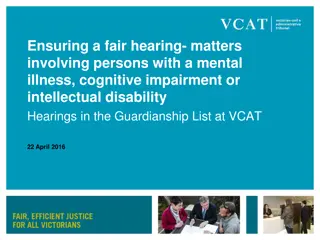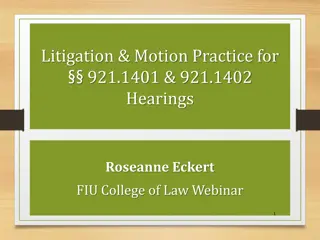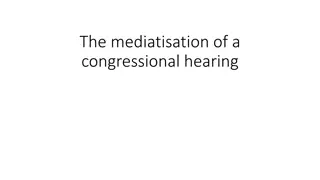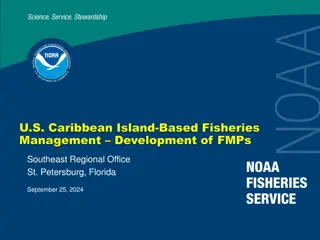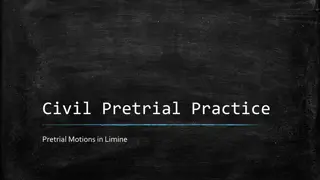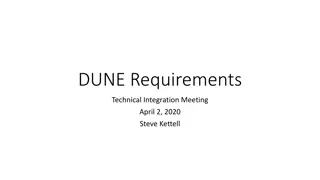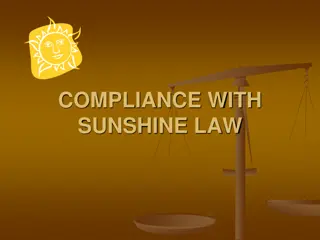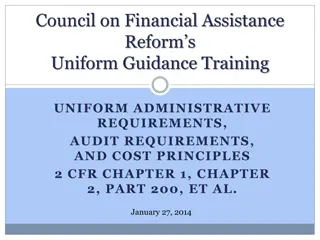Understanding Evidentiary Requirements in Administrative Hearings
Explore the key facets of presenting evidence in administrative hearings, including recognizing unusual evidentiary situations, creating relevant records, analyzing implications, and confidently ruling on evidence. Learn how evidence must be probative, relevant, and exclude certain types. Discover how agencies can use their expertise in evaluating evidence and the importance of explaining rulings on objections in administrative hearings.
- Evidentiary Requirements
- Administrative Hearings
- Probative Evidence
- Agency Expertise
- Legal Proceedings
Download Presentation

Please find below an Image/Link to download the presentation.
The content on the website is provided AS IS for your information and personal use only. It may not be sold, licensed, or shared on other websites without obtaining consent from the author. Download presentation by click this link. If you encounter any issues during the download, it is possible that the publisher has removed the file from their server.
E N D
Presentation Transcript
Tom Dewberry, Chief Judge Denise Shaffer, Director of Quality Assurance Maryland Office of Administrative Hearings Evidence in Administrative Hearings
Learning Objectives Learning Objectives 1. Be able to recognize situations that present unusual evidentiary questions. 2. Be able to create a record containing relevant, authenticated evidence 3. Be able to properly analyze the implications to the hearing process of situations that present unusual evidentiary questions or a non-traditional request to consider evidence. 4. Be able to rule confidently in situations involving unusual evidentiary questions.
Evidence Must Be Probative Reasonable and prudent individual commonly accepted in the conduct of their affairs. Exclude: Incompetent Irrelevant Immaterial Unduly repetitious Hearsay Not excluded solely because hearsay
Agency or OAH may use its experience, technical competence, and specialized knowledge in the evaluation of evidence Official Notice Examples from MD OAH HGN, OLS Medical terms from dictionary or DSM MA and FSP Manuals SSA Dictionary of Occupations and Exertional Levels OAH bound by agency Regulation Prior adjudication Declaratory ruling Other settled, preexisting policy
Unreliable hearsay Incompetent Irrelevant Immaterial Unduly repetitious Asked and answered
Courts in various jurisdictions have commented that it is a good practice for trial courts to explain their rulings on objections. See, e.g., Citibank S. Dakota, N.A. v. Wood, 862 N.E.2d 576, 588 (Ohio App. 2006); Atkins v. Johnson, 342 S.W.2d 648, 650 (Tex. Civ. App. 1961);State v. Carter, 451 S.W.2d 340, 345 (Mo. 1970). Such an explanation can provide guidance to the attorneys. An attorney may be unaware of a judge s view that certain evidence is inadmissible in a particular administrative hearing. The attorney may continue to offer evidence that the judge views as not relevant until the judge explains his or her reasons for excluding the evidence in question. Doing so helps provide a more complete record for a court to consider on judicial review.
Section 10-213(a)(1) of the State Government Article requires each party in an administrative case to offer all of the evidence that the party wishes to have made part of the record. Based on this provision, it is Maryland OAH practice that if a judge excludes evidence, the proponent of the evidence must be permitted to make a proffer. Failure to make a proffer compromises the record and may preclude judicial review
[T]he act of proving that something (as a document) is true or genuine. Sublet v. State, 442 Md. 632, 655 (2015). Query: claims it is? Query: Is the evidence what its proponent If a piece of evidence is not properly authenticated, it is incompetent.
The author may authenticate. A person familiar with author s signature may authenticate Reply letter doctrine: the document appears to be prompt response to another authenticated letter written to signatory. Contents information in the document is known (or, better yet, is known only) to the signatory. Some documents may be self-authenticating (public records under seal; certified copies of public records).
Two distinct methods to authenticate photos (or video): (1) witness testimony from firsthand knowledge that the video (or photo) fairly and accurately represents the scene or object it purports to depict as it existed at the relevant time; or (2) the silent witness theory of admissibility, under which a video (or photo) speaks with its own probative effect. Under the silent witness theory, the proponent must present evidence regarding the type of recording equipment, how the footage was focused, how reliable the images were, etc.
For purposes of authentication, video recordings are treated like photographs Case Study: Washington v. State, 406 Md. 642 (2008) Washington: improper authentication where footage from eight security cameras was distilled into a single video through undisclosed mechanisms.
Challenges: No conventional signature Problems of fraud, hacking, unauthorized use Opportunities for anonymity General Considerations: The burden of proof for authentication is a low one. Authentication may be accomplished by direct or circumstantial evidence. Authentication may be accomplished entirely by substantial evidence.
Printout of email bearing senders email address provides circumstantial evidence that message was transmitted by the person identified in the email address. Successfully replying to the sender s email address indicates that message was originally sent from that address. Contents of email may authenticate email by showing details known to alleged sender. Email address is not conclusive. Email message can be sent by person other than named sender. Person with unauthorized access to computer can send email message under owner s name
Case Study: Sublet v. State, 442 Md. 632 (2015) Most case law is from criminal cases. Printout of communications on Facebook among alleged victims of assault. But witness denied that she had sent one of threatening messages her bf [the defendant] is a dead man walkn. Witness claimed that others had access to her logon information and password. No evidence refuted witness s claim. HELD: Communication was not authenticated.
After defendant stabs his girlfriend, remorseful messages, purportedly from him, start to appear on her Facebook page. Messages were written very shortly after the stabbing, when very few people would ve known of it. Victim testified that defendant started calling her to apologize at about the same time and that he later wrote her a letter of apology. Messages were properly authenticated.
Case Study: Sublet v. State, 442 Md. 632 (2015) Police recovered the messages and tweets from mobile phones in defendant s possession. Messages reflected a conversation between two persons with two aliases or tags. One of the tags had the defendant s photo next to it. Witnesses said that that tag belonged to the defendant. Witness said that the defendant and another person, who was identified as the person who used the other tag, were planning the assault discussed in the messages. Messages were adequately authenticated.
Case Study: Dickens v. State, 175 Md. App. 231 (2007) No question that defendant killed his wife. Only question is premeditation. Victim received threatening messages in days or months before she is killed. Some of the messages were sent from defendant s phone, which was found near the scene of the crime. Although some messages could not be tracked to defendant s phone, they contained information that only he would know. Some messages were from Doll/M, which the court took to be a reference to Dial M for Murder. Messages were properly authenticated.
You are conducting an unemployment hearing. Seventeen year old Billy Bourbon is appearing before you after being fired for coming to work with alcohol on his breath. Billy shows up wearing basketball shorts, a Bud Lite hat turned backwards and wearing a tee shirt that says Grab a Heiney and has a beer bottle on it. Can you consider Billy s dress as evidence in the case? Why or why not?
You are conducting an unemployment hearing. Justin Time, a government employee, is challenging a termination for cause for his 39th occasion of tardiness in the last year. The hearing is scheduled to begin at 9:00 am. It is now 9:15 am and the representative for the agency that took the discipline asks that you find Mr. Time in default for failing to appear. Before you can rule, Time rushes into the room, sits down, apologizes for being late and mumbles something about a flat tire. You deny the motion and begin the hearing. Can you consider Time s tardiness as evidence in the hearing? Why or why not?
You are conducting disability hearings for the state. After a hearing you conclude that the appellant, Steven Hawking, is not disabled. In writing your decision you arrive at this conclusion, in part, because you observed that Mr. Hawking s demeanor at the hearing was not consistent with the presence of any physical or mental impairment and that he tolerated the hearing very well. Will this demeanor based assessment withstand scrutiny? Why or why not?
You have a motor vehicle license hearing docket. In your first case, the appellant, Mike Phelps, is trying to get his license back after it was revoked for multiple alcohol violations. The hearing begins and Mr. Phelps testifies that without a license he does not drive and that he really needs his driver s license to go to church, make it to swimming practice and attend alcohol counseling. The hearing has to be continued because Phelps s witness, an alcohol counselor, had an emergency and could not attend the hearing. You adjourn the hearing. It s a nice day so you step outside for some fresh air before calling the next case. While outside, you see Phelps enter a car, get behind the wheel, and drive out of the parking lot. Can you consider Phelps s conduct as evidence in his continued hearing? Why or why not?
You are conducting unemployment hearings (again!) David Berkowitz, a crime scene investigator, is challenging his termination. You start the hearing and begin reading the charges which led to the termination, which begin: We are proposing to discharge the employee due to his unacceptable behavior in the work place, the employee is consistently argumentative and paranoid. At this point, Berkowitz jumps up and screams at you that the charges are untrue, agency management is just out to get him! Can you consider Berkowitz s outburst as evidence in the case? Why or why not?
